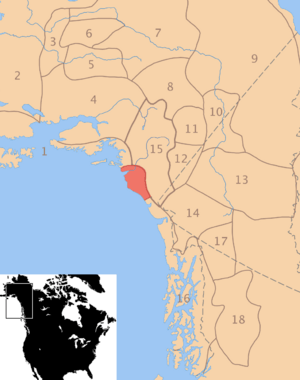Eyak facts for kids

Pre-contact distribution of Eyak
|
|
| Regions with significant populations | |
|---|---|
| 428 | |
| Languages | |
| English, Eyak (historical) | |
| Religion | |
| Christianity | |
| Related ethnic groups | |
| Tlingit, Ahtna, Chugach Sugpiaq | |
The Eyak are a group of Native American people. They traditionally lived in Alaska, near the Copper River Delta and the town of Cordova, Alaska. The Eyak people called themselves dAXunhyuu, which means "the people."
Today, Eyak people live in different places like Cordova and Yakutat. The Native Village of Eyak is a recognized tribe. However, not all Eyak descendants can join this tribe. This is because the rules often require members to live in Cordova most of the year.
Where the Eyak Lived
The Eyak people lived in an area that stretched from what is now Cordova. Their land went east to the Martin River and north to Miles Glacier.
They had four main villages:
- Alaganik, located near Mile 21 of the Copper River Highway today.
- Eyak, found near Mile 5.5.
- An unnamed village, 800 yards south of Eyak.
- Orca, which is now part of Cordova.
Besides these main villages, the Eyak also had seasonal fish camps. These were at Point Whitshed and Mountain Slough.
The name Eyak comes from another group, the Chugach Sugpiaq. They called an Eyak village Igya'aq. This village was located at the mouth of the Eyak River.
Eyak History
The Eyak people first moved from inland areas down the Copper River to the coast. Here, they found many salmon to fish.
When Russian explorers arrived, they saw the Eyak as a unique culture. They even marked Eyak territory on their maps. The Russians traded with the Eyak and sent missionaries to them.
Because the Eyak had a small population, other groups sometimes raided their land. The Chugach people, who lived to the west, put pressure on Eyak territory. The Tlingit people, to the east, had better relations with the Eyak. This led to many Eyak people marrying Tlingit people and joining their communities. This also pushed the Eyak's land further west and made their population smaller.
When Americans arrived, they started building canneries to process fish. This meant more competition for salmon. Also, new diseases brought by non-native settlers caused the Eyak population to drop even more.
As their numbers decreased, the remaining Eyak gathered near the village of Orca. In 1880, the village of Alaganik had 117 people. By 1890, only 48 remained. In 1900, the total Eyak population was estimated at 60. As more settlers came, the village of Orca grew into the town of Cordova.
By 1996, about 120 people were living who had some Eyak heritage. The last person who was full-blood Eyak, Marie Smith Jones, passed away on January 21, 2008.
The Eyak Language
The Eyak people spoke a special language. It was closely related to the Athabaskan languages. Over time, the Eyak language began to disappear. This happened because of pressure from neighboring groups and the spread of English.
Marie Smith Jones (1918–2008) was the very last person to speak Eyak as her first language. A language expert named Michael E. Krauss is well-known for his work on the Eyak language.
Notable Eyak People
- Marie Smith Jones, the last person to speak the traditional Eyak language fluently.
See also
 In Spanish: Eyak para niños
In Spanish: Eyak para niños

